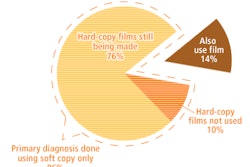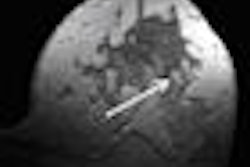Amidst reports that mammography use is down and fewer radiologists want to specialize in the modality, the idea that mammography, specifically digital, could be a revenue generator for outpatient centers may come as a surprise. But some say breast imaging has reached a turning point, and with a streamlined workflow process, outpatient imaging facilities can make mammography pay.
The modality also has something else going in its favor: Both the government and commercial insurers aren't targeting it for reimbursement cuts or the preauthorization processes that radiology benefits management (RBM) programs require for MRI and CT exams, according to Brigette LaBar, an independent radiology practice management and reimbursement consultant in Irvine, CA.
Arguments are being made that other procedures that are components of women's breast imaging should likewise be exempt from proposed reductions in the Medicare Physician Fee Schedule, LaBar said. She spoke at the recent Radiology Business Management Association (RBMA) Imaging Center conference in New Orleans.
“An efficient digital mammography facility can get reimbursement on par with MRI rates, in the range of $537 to $631 per hour.”
"For now, mammography is something of a 'sacred cow,' as evidenced by its exclusion from the 2005 [Deficit Reduction Act] cuts," LaBar said. "Commercial insurers also show a propensity to exclude mammography from fee schedule decreases, because their members demand access. And although imaging centers are facing new costs, driven by RBMs, mammography appears to be almost universally excluded from precertification processes."
Need proof? According to LaBar, taking into account the transition to digital (based on national averages), Medicare reimbursement for screening mammography increased 37% from 2002 to 2009, while in the same time frame, reimbursement for noncontrast MRI spinal studies decreased by 24%.
Combine digital mammography's efficiency and solid reimbursement status, and the financial picture for mammography begins to look rosier, according to Deborah MacFarlane, president of HealthEdge, a consulting firm in San Diego that provides business development, marketing, and strategic planning services to healthcare providers, with a specific focus on radiology. MacFarlane outlined this picture at the RBMA conference.
"Radiologists haven't wanted to specialize in mammography, and the modality has long been considered the low revenue producer on the totem pole," MacFarlane said. "But if a facility controls the technical component for mammography, it can actually make money with digital."
Workflow works wonders
Workflow efficiency is key to making money with mammography, MacFarlane said. Traditionally, facilities performing analog mammography allocated 30-minute time slots for screening exams. Now, with digital, it's possible for facilities to do exams in 10- to 15-minute slots, which further improves their bottom line.
For example, under Medicare rates in California, an efficient digital mammography facility can get reimbursement on par with MRI rates, in the range of $537 to $631 per hour, assuming they can do screening mammography exams in 15-minute time frames, according to MacFarlane.
"If you look at it that way, the modality has gone from being a loss leader, losing $10, say, for every analog mammography exam performed, to being a revenue generator with digital's increased throughput," MacFarlane said.
So assessing a facility's workflow protocols, from both physical space and staffing perspectives, is the place to start if that facility wants to see increased revenue from digital mammography, according to Bonnie Rush, consultant and president of Breast Imaging Specialists of San Diego. Rush also presented at the RBMA meeting.
"Evaluate where major time is spent [during the mammography screening exam process] and then revamp it using technologist aides or a patient concierge/patient advocate," Rush said. "Taking all those analog steps that technologists have done before and assigning them to staff that makes less money in and of itself can boost revenue."
This tactic can also be good for patients: When a woman is greeted and guided through the registration, health history, and exam prep by someone who is directly focused on her -- hard for technologists to do, as they're concentrating on getting the exam done and moving on to the next patient -- her experience of the facility's customer service will be more positive.
It's also worth considering whether physical space or staff can be reallocated or redesigned, Rush said. Can file room staff be moved into IT jobs? Can that unused file room then be made into dressing rooms? Are the reading rooms ergonomic, so that radiologists don't fatigue as easily, as they do their batch readings (another technique that speeds workflow)? Can any films that need to be digitized be handled by ancillary staff the night before, rather than during the busy workday?
"Do a workflow and space design analysis," Rush said. "Walk through it piece by piece to find out how many steps it takes to do an exam, from when the patient is first greeted to when she leaves."
RIS, HIS, or PACS: Not optional
Without a RIS/HIS or PACS network, it's tough to be productive with digital mammography, according to Rush. "Unless you have those electronic tools, double entry is always going to lead to decreased productivity or errors where images aren't matched to patients correctly," she said.
Ensure that the facility's PACS network has the transmission speed and archival capabilities necessary for the workload. "You're not going to get the speed needed to bring in revenue if the interpreting physician can't pull up images fast enough to keep up with the workflow," Rush said.
And multimodality workstations offer a productivity advantage over dedicated mammography stations, Rush said. Radiologists need to be able to interpret screening mammograms with any other exams the woman has undergone on hand.
Loss leader to revenue maker
Women's imaging has long been tough to market for outpatient-based providers, according to MacFarlane. But the tide is turning.
"Hospitals have been aggressive in how they market mammography services, and it has made sense for them to do that, since they have the downstream revenue from chemotherapy, radiation, and surgery," MacFarlane said. "But now, with the efficiency of digital mammography and the status of reimbursement for the modality, it's starting to make good economic sense in the outpatient imaging center as well."
By Kate Madden Yee
AuntMinnie.com staff writer
April 9, 2009
Related Reading
Research assesses mammography's value, April 2, 2009
Mammography procedure volume drops 16% since 2000, March 17, 2009
Radiologists overestimate breast imaging malpractice risk, February 9, 2009
Breast centers can manage malpractice risk, January 13, 2009
Treatment delays common in men with breast cancer, July 8, 2008
Copyright © 2009 AuntMinnie.com




















